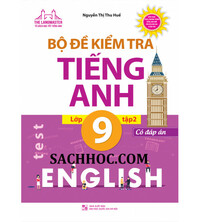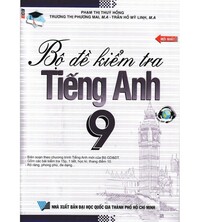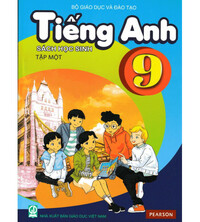Đề thi vào 10 môn Anh Bắc Giang năm 2023
Mark the letter A, B, C, or D on your answer sheet to show the underlined part that needs correcting. Mark the letter A, B, C, or D on your answer sheet to indicate the sentence that has the same meaning as the original one. Read the following passage and mark the letter A, B, C, or Don your answer sheet to indicate the correct answer to each of the questions. Mark the letter A, B, C, or D on your answer sheet to indicate the correct answer to each of the following sentences.
Đề bài
PHẦN A: TRẮC NGHIỆM (8.0 điểm)
Listening (2.0 pts)
Part 1: Listen to four short conversations and mark the letter A, B, or C on your answer sheet to indicate the appropriate answer to each of the following questions. You will listen TWICE. (1.0 pt)
Question 1: How much did the girl pay for her sports bag?
A. £8.50
B. £9.80
C. £7.10
Question 2: Which instrument does
A. The trumpet
B. The piano
C. The violin
Question 3: What is Finley's brother doing?
A. Having lunch
B. Sleeping
Ċ. Playing volleyball
Question 4: Where were they in the morning?
A. At the swimming pool
B. At home
C. At the café
Part 2: Listen to the conversation between Emily and Oscar. Mark the letter A, B or C on your answer sheet to indicate the appropriate answer to each of the following questions. You will listen TWICE (1.0 pt)
Question 5: How often does Emily visit her aunt?
A. Every three years
B. Every two years
C. Every year
Question 6: Young bears leave their mothers when they are about ______ months old.
A .six
B. thirty
C.eighteen
Question 7: Where did Oscar find the spider?
A. On the bed
B. On the stairs
C. On the wall
Question 8: What did Emily think of the weather?
A. It was good for swimming
B. It was hard to stay cool.
C. It was not really hot.
--- THE END OF THE LISTENING ---
Read the following passage and mark the letter A, B, C or D on your answer sheet to indicate the correct answer to each of the following questions. (1.0 pt)
Music is a huge part of a teenager's life, and most of us can't imagine life without it. Hip-hop, rock, rap, country, jazz, heavy metal, and others attract many young fans. But teens do more than listen. Some three million American teens study music in school, through private lessons, or simply on their own and thousands participate in "garage bands", practicing and creating songs in the garages of their own or their friends' homes.
High school can be a very stressful time. That's why music is so important to many teens. It helps us cope with the daily stresses of school and helps us avoid pressure from our parents. It helps us to express our emotions and comforts us when we feel no one understands us.
The beauty of music is that there are so many kinds and so many ways to connect to it. A girl I know fell in love with music when she was twelve. She was going through a lot with her family, and her dad helped her through it by showing her the power of music before he died. She says music helps her get away from her problems and keeps her feeling okay when everything in her life is hard.
Everyone has his or her own personal connection to music. Personally speaking, I find that music fills me with something wonderful that I can't even begin to explain. What's your connection?
Question 9: What is the main topic of the passage?
A. The role of music in a teen's life.
B. The ways teens cope with stress.
C. The rise of music lovers in America.
D. The most popular forms of music.
Question 10: What does the word "express" in paragraph 2 probably mean?
A. show
B. control
C. hide
D. spread
Question 11: The girl in paragraph 3 fell in love with music when she was
A. 10
B. 12
C. 22
D. 20
Question 12: Which of the following is NOT TRUE according to the passage?
A. Millions of teens in America study music.
B. Thousands of teens in America participate in "garage bands".
C. Music helps us deal with stresses and avoid pressure.
D. People all have the same connection to music.
Mark the letter A, B, C or D on your answer sheet to indicate the correct answer to each of the following questions. (3.0 pts)
Question 13: You have to ______ on the word 'Next' to see the next web page.
A. pull
B. click
C. push
D. hit
Question 14: The bicycle _____ my parents gave me on my birthday was stolen yesterday.
A which
B. who
C. what
D. whom
Question 15: Jack is in an art class.
Teacher: "What a wonderful painting, Jack!"
Jack: "________.”
A. That sounds good
B. Thank you
C. I'd love to
D. You're welcome
Question 16: My grandparents often make Chung cakes - our traditional _____ at Tet.
A. decoration
B. fruit
C. food
D. customs
Question 17: If the twins weren't busy, they _____ their grandparents more often.
A. had seen
B. saw
C. will see
D. would see
Question 18: Simon hasn't read that book before,______?
A. did he
B. does he
C. is he
D. has he
Question 19: The music is so loud. Could you please _____?
A. look after it
B. turn it down
C. take it off
D. turn it on
Question 20: The film was boring, so my father turned off the TV and_____ to bed.
A. got
B. made
C. went
D. stayed
Question 21: With a little hard work, I'm sure you'll _______ a lot this year.
A. succeed
B. qualify
C. reach
D. achieve
Question 22: The price of batteries has gone up. They are a lot _____ than last time.
A. more expensive
B. expensive
C. the most expensive
D. as expensive
Question 23: Peter and Jenifer are talking to each other at a party.
Peter: "Would you like something for dessert?"
Jenifer: “______. I'm full already."
A. Congratulations
B. I'm sorry
C. No, thanks
D. It was the least that I could do
Question 24: Nguyễn Thị Oanh, an athlete from Bac Giang,_______ four gold medals at the 32nd SEA Games last month.
A. win
B. to win
C. winning
D. won
Mark the letter A, B, C or D on your answer sheet to indicate the word whose underlined part differs from the other three in pronunciation in each of the following questions (1.0 pt)
Question 25:
A. writer
B. until
C. style
D. future
Question 26:
A. trains
B. paintings
C. controls
D. groups
Question 27:
A. listened
B. moved
C. wanted
D. called
Question 28:
A. trend
B. event
C. decide
D. setting
Read the following passage and mark the letter A, B, C or D on your answer sheet to indicate the correct word or phrase that best fits each of the numbered blanks. (1.0 pt)
How Personalities Develop?
If you're a teenager, you know that the way you behave and feel in different (29) ______ situations changes as you get older. So, you might be interested in a new study about bow teenagers' personalities develop. From about thirteen years old, it becomes more important to act in a way that means other people will like you. Also, we start to become keen (30) _______ and more serious about our work and study. We become good at (31) ______ rules and we want to complete tasks that we started much more than we did when we were younger. The big question in the study was whether our friends affect our behaviour towards others. The results show we choose to hang out with people who are like us, (32) _______ that does not mean we change because of them. In fact, we stay the same we just choose friends who are similar to us!
Question 29:
A. society
B. socialize
C. socially
D. social
Question 30:
A. of
B. in
C. on
D. at
Question 31:
A. following
B. carrying
C. realizing
D. watching
Question 32:
A. and
B. but
C. so
D. or
PHẦN B: TỰ LUẬN (2.0 điểm)
I. Rearrange the following words or phrases to make meaningful sentences. (0.5 pt)
Question 1: to give us / I / my teacher / didn't expect / so much homework.
→ _____________________________________.
Question 2: yesterday /was / Emma didn't go / because / to school / she / ill.
→ _____________________________________.
II. Rewrite each sentence so that it means the same as the first one, beginning with the given word(s). (0.5 pt)
Question 1: We have chosen Helen as the new monitor of our class.
→ Helen ________________________________.
Question 2: "I will try to finish the work this afternoon," the man said.
→The man said __________________________.
III. Paragraph writing. (1.0 pt)
In about 100 words, write a paragraph about three things you would like to do after finishing this exam.
-THE END-
Đáp án
HƯỚNG DẪN GIẢI
THỰC HIỆN: BAN CHUYÊN MÔN LOIGIAIHAY.COM
PHẦN A: TRẮC NGHIỆM

PHẦN B: TỰ LUẬN
I.
1. I didn’t expect my teacher to give us so much homework.
2. Emma didn’t go to school yesterday because she was ill.
II.
1. Helen has been chosen as the new monitor of our class.
2. The man said he would try to finish the work that afternoon.
HƯỚNG DẪN GIẢI CHI TIẾT
PHẦN A: TRẮC NGHIỆM
9. (TH)
Kiến thức: Đọc hiểu
Giải thích: Chủ đề chính của đoạn văn là gì?
A. The role of music in a teen's life: Vai trò của âm nhạc trong cuộc sống thanh thiếu niên.
B. The ways teens cope with stress: Cách thanh thiếu niên đối phó với căng thẳng
C. The rise of music lovers in America: Làn sóng yêu nhạc ở Mỹ
D. The most popular forms of music: Những hình thức âm nhạc phổ biến nhất.
Thông tin: Music is a huge part of a teenager's life, and most of us can't imagine life without it. Hip-hop, rock, rap, country, jazz, heavy metal, and others attract many young fans.
Tạm dịch: Âm nhạc là một phần quan trọng trong cuộc sống của thanh thiếu niên và hầu hết chúng ta không thể tưởng tượng được cuộc sống nếu không có nó.
Đáp án A.
10. (TH)
Kiến thức: Đọc hiểu
Giải thích: Từ “express” ở đoạn 2 có lẽ có nghĩa là gì?
A. show (v): hiển thị
B. control (v): kiểm soát
C. hide (v): ẩn
D. spread (v): lây lan
- express (v): nhấn mạnh, diễn tả, bày tỏ
Đáp án A.
11. (TH)
Kiến thức: Đọc hiểu
Giải thích: Cô gái ở đoạn 3 yêu âm nhạc khi cô ấy ______tuổi.
A. 10
B. 12
C. 22
D. 20
Thông tin: A girl I know fell in love with music when she was twelve.
Tạm dịch: Một cô gái mà tôi biết đã yêu âm nhạc khi mới 12 tuổi.
Đáp án B.
12. (TH)
Kiến thức: Đọc hiểu
Giải thích: Điều nào sau đây KHÔNG ĐÚNG theo đoạn văn?
A. Millions of teens in America study music: Hàng triệu thanh thiếu niên ở Mỹ học nhạc.
B. Thousands of teens in America participate in "garage bands": Hàng nghìn thanh thiếu niên ở Mỹ tham gia vào các "ban nhạc trong ga-ra".
C. Music helps us deal with stresses and avoid pressure: Âm nhạc giúp chúng ta giải quyết căng thẳng và tránh áp lực.
D. People all have the same connection to music: Tất cả mọi người đều có cùng mối liên hệ với âm nhạc.
Thông tin: Everyone has his or her own personal connection to music.
Tạm dịch: Mọi người đều có mối liên hệ cá nhân của riêng mình với âm nhạc.
Đáp án D.
Dịch bài đọc:
Âm nhạc là một phần quan trọng trong cuộc sống của thanh thiếu niên và hầu hết chúng ta không thể tưởng tượng được cuộc sống nếu không có nó. Hip-hop, rock, rap, country, jazz, Heavy Metal và những thể loại khác thu hút nhiều người hâm mộ trẻ tuổi. Nhưng thanh thiếu niên làm nhiều hơn là chỉ lắng nghe. Khoảng ba triệu thanh thiếu niên Mỹ học nhạc ở trường, thông qua các bài học riêng, hoặc đơn giản là tự học và hàng nghìn thanh thiếu niên tham gia vào các "ban nhạc trong ga-ra", luyện tập và sáng tác các bài hát trong ga-ra nhà riêng của họ hoặc nhà bạn bè của họ.
Trường trung học có thể là một thời gian rất căng thẳng. Đó là lý do tại sao âm nhạc rất quan trọng đối với nhiều thanh thiếu niên. Nó giúp chúng ta đương đầu với những căng thẳng hàng ngày ở trường và giúp chúng ta tránh được áp lực từ cha mẹ. Nó giúp chúng ta bày tỏ cảm xúc và an ủi chúng ta khi cảm thấy không ai hiểu mình.
Vẻ đẹp của âm nhạc là có rất nhiều thể loại và rất nhiều cách để kết nối với nó. Một cô gái mà tôi biết đã yêu âm nhạc khi mới 12 tuổi. Cô đã trải qua rất nhiều khó khăn cùng gia đình và bố cô đã giúp cô vượt qua điều đó bằng cách cho cô thấy sức mạnh của âm nhạc trước khi ông qua đời. Cô cho biết âm nhạc giúp cô thoát khỏi những vấn đề và giúp cô cảm thấy ổn khi mọi thứ trong cuộc sống đều khó khăn.
Mọi người đều có mối liên hệ cá nhân của riêng mình với âm nhạc. Cá nhân tôi thấy rằng âm nhạc mang lại cho tôi điều gì đó tuyệt vời mà tôi thậm chí không thể giải thích được. Kết nối của bạn là gì?
13. (TH)
Kiến thức: Từ vựng
Giải thích:
A. pull (v): kéo
B. click (v): bấm
C. push (v): đẩy
D. hit (v): đánh
Tạm dịch: Bạn phải bấm vào chữ “Next” để xem trang web tiếp theo.
Đáp án B.
14. (TH)
Kiến thức: Cấu trúc cơ bản
Giải thích:
A. which: cái mà, cái nào
B. who: ai
C. what: cái gì
D. whom: ai
Tạm dịch: Chiếc xe đạp mà bố mẹ tặng nhân dịp sinh nhật tôi đã bị trộm hôm qua.
Đáp án A.
15. (TH)
Kiến thức: Cấu trúc cơ bản
Giải thích:
A. That sounds good : Nghe hay đấy
B. Thank you: Cảm ơn bạn
C. I'd love to: ôi rất vui lòng
D. You're welcome: Không có gì
Tạm dịch: Jack đang học lớp nghệ thuật.
Giáo viên: "Thật là một bức tranh tuyệt vời, Jack!"
Jack: " Cảm ơn bạn."
Đáp án B.
16. (TH)
Kiến thức: Từ vựng
Giải thích:
A. decoration (n): trang trí
B. fruit (n): trái cây
C. food (n): thực phẩm
D. customs (n): phong tục
Tạm dịch: Ông bà tôi thường làm bánh chưng - món ăn truyền thống của nước ta vào dịp Tết.
Đáp án C.
17. (TH)
Kiến thức: Cấu trúc cơ bản
Giải thích:
- Câu điều kiện loại 2: If + S + V (quá khứ đơn), S + would + V-infinitive
Tạm dịch: Nếu cặp song sinh không bận rộn thì chúng sẽ được gặp ông bà thường xuyên hơn.
Đáp án D.
18. (TH)
Kiến thức: Cấu trúc cơ bản
Giải thích:
- Câu hỏi đuôi: Subject + verb + (object) + (…) + , + trợ động từ + subject/ đại từ tương ứng với subject + ?
Tạm dịch: Simon chưa từng đọc cuốn sách đó phải không?
Đáp án D.
19. (TH)
Kiến thức: Cấu trúc cơ bản
Giải thích:
A. look after it: chăm sóc nó
B. turn it down: từ chối
C. take it off: dẫn đi, đưa đi
D. turn it on: bật nó lên
Tạm dịch: Âm nhạc quá to. Bạn có thể vui lòng tắt nó xuống được không?
Đáp án B.
20. (TH)
Kiến thức: Cấu trúc cơ bản
Giải thích:
A. got: có được
B. made: làm
C. went: đi
D. stayed: ở lại
Tạm dịch: Phim chán nên bố tôi tắt tivi và đi ngủ.
Đáp án C.
21. (TH)
Kiến thức: Từ vựng
Giải thích:
A. succeed (v): thành công
B. qualify (v): đủ điều kiện
C. reach (v): đạt được
D. achieve (v): đạt được
Tạm dịch: Chỉ cần chăm chỉ một chút, tôi chắc chắn bạn sẽ đạt được nhiều thành tựu trong năm nay.
Đáp án D.
22. (TH)
Kiến thức: Cấu trúc cơ bản
Giải thích:
- So sánh hơn với tính từ dài: more + adj (dài) + than
Tạm dịch: Giá ắc quy tăng cao. Chúng đắt hơn rất nhiều so với lần trước.
Đáp án A.
23. (TH)
Kiến thức: Cấu trúc cơ bản
Giải thích:
A. Congratulations: Xin chúc mừng
B. I'm sorry: Tôi xin lỗi
C. No, thanks: Không, cảm ơn
D. It was the least that I could do: Đó là điều tối thiểu tôi có thể làm
Tạm dịch: Peter và Jenifer đang nói chuyện với nhau tại một bữa tiệc.
Peter: "Bạn có muốn ăn gì tráng miệng không?"
Jennifer: “Không, cảm ơn. Tôi đã no rồi."
Đáp án C.
24. (TH)
Kiến thức: Mệnh đề quan hệ rút gọn
Giải thích: Mệnh đề quan hệ đầy đủ: Nguyễn Thị Oanh, an athlete from Bac Giang, who won four gold medals at the 32nd SEA Games last month.
Trong mệnh đề quan hệ rút gọn, nếu động từ ở dạng chủ động => rút gọn thành V-ing
Trong mệnh đề quan hệ rút gọn, nếu động từ ở dạng bị động => rút gọn thành Ved/VP2
Tạm dịch: Nguyễn Thị Oanh, vận động viên quê Bắc Giang, giành 4 huy chương vàng tại SEA Games 32 vào tháng trước.
Đáp án D.
25. (TH)
Kiến thức: Phát âm
Giải thích:
A. writer /ˈraɪtə(r)/
B. until /ənˈtɪl/
C. style /staɪl/
D. future /ˈfjuːtʃə(r)/
Phương án D phát âm là /tʃ/, các phương án còn lại phát âm là /t/.
Đáp án D.
26. (TH)
Kiến thức: Phát âm
Giải thích:
A. trains /treɪnz/
B. paintings /ˈpeɪntɪŋz/
C. controls /kənˈtrəʊlz/
D. groups /ɡruːps/
Phương án D phát âm là /s/, các phương án còn lại phát âm là /z/.
Đáp án D.
27. (TH)
Kiến thức: Phát âm
Giải thích:
A. listened /ˈlɪsned/
B. moved /muːved/
C. wanted /ˈwɒntɪdid/
D. called /kɔːled/
Phương án C phát âm là /id/, các phương án còn lại phát âm là /d/.
Đáp án C.
28. (TH)
Kiến thức: Phát âm
Giải thích:
A. trend /trend/
B. event/ɪˈvent/
C. decide /dɪˈsaɪd/
D. setting /ˈsetɪŋ/
Phương án C phát âm là /i/, các phương án còn lại phát âm là /e/.
Đáp án C.
29. (TH)
Kiến thức: Đọc hiểu
Giải thích:
A. society (n): xã hội
B. socialize (v): xã hội hóa
C. socially (adv): xã hội
D. social (adj): xã hội
Tạm dịch: Nếu bạn là một thiếu niên, bạn biết rằng cách bạn cư xử và cảm nhận trong các tình huống xã hội khác nhau sẽ thay đổi khi bạn già đi.
Đáp án D.
30. (TH)
Kiến thức: Đọc hiểu
Giải thích:
- keen on: muốn làm điều gì đó một cách nhiệt tình, hăng hái.
Tạm dịch: Ngoài ra, chúng ta bắt đầu trở nên quan tâm và nghiêm túc hơn trong công việc và học tập của mình.
Đáp án C.
31. (TH)
Kiến thức: Đọc hiểu
Giải thích:
A. following (v): đi theo
B. carrying (v): chở
C. realizing (v): nhận ra
D. watching (v): quan sát
Tạm dịch: Chúng ta trở nên giỏi tuân theo các quy tắc và chúng ta muốn hoàn thành những nhiệm vụ mà chúng ta đã bắt đầu nhiều hơn so với khi chúng ta còn trẻ.
Đáp án A.
32. (TH)
Kiến thức: Đọc hiểu
Giải thích:
A. and: và
B. but: nhưng
C. so: vậy
D. or: hoặc
Tạm dịch: Kết quả cho thấy chúng ta chọn đi chơi với những người giống mình nhưng điều đó không có nghĩa là chúng ta thay đổi vì họ.
Đáp án B.
PHẦN B: TỰ LUẬN
I.
1. (TH)
Kiến thức: Cấu trúc cơ bản
Giải thích:
- expect something: mong đợi điều gì…
Tạm dịch: Tôi không ngờ giáo viên lại giao cho chúng tôi nhiều bài tập đến vậy.
Đáp án: I didn’t expect my teacher to give us so much homework.
2. (TH)
Kiến thức: Cấu trúc cơ bản
Giải thích:
- S + V because S + V: bởi vì…
Tạm dịch: Hôm qua Emma không đến trường vì cô ấy bị ốm.
Đáp án: Emma didn’t go to school yesterday because she was ill.
II.
1. (TH)
Kiến thức: Cấu trúc cơ bản
Giải thích:
- Bị động thì hiện tại hoàn thành: have/ has + been + V-ed/ PII
Tạm dịch: Helen đã được chọn làm giám thị mới của lớp chúng tôi.
Đáp án: Helen has been chosen as the new monitor of our class.
2. (TH)
Kiến thức: Cấu trúc cơ bản
Giải thích:
- Câu tường thuật: S1 + said + (that) + S2 + V (lùi 1 thì so với câu gốc)
Tạm dịch: Người đàn ông nói rằng anh ta sẽ cố gắng hoàn thành công việc vào chiều hôm đó.
Đáp án: The man said he would try to finish the work that afternoon.
Search google: "từ khóa + timdapan.com" Ví dụ: "Đề thi vào 10 môn Anh Bắc Giang năm 2023 timdapan.com"







